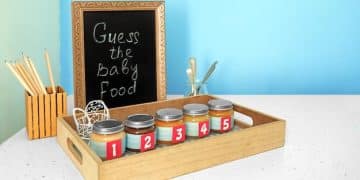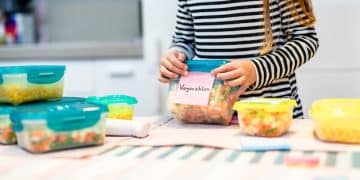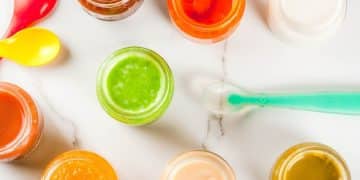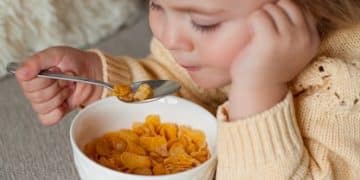Baby Food Storage: Keep Homemade Purees Fresh for 3 Months

Baby food storage is essential for busy parents who want to provide nutritious homemade purees. Proper techniques, including freezing in small portions and using airtight containers, can keep your baby’s food fresh for up to 3 months.
Making your own baby food is a wonderful way to ensure your little one gets the freshest, most nutritious meals. But what about baby food storage? How can you keep those homemade purees fresh and safe for your baby for up to 3 months? This guide will walk you through everything you need to know.
Mastering Baby Food Storage for Freshness
Preparing baby food at home offers numerous benefits, from controlling ingredients to saving money. However, knowing how to properly store it is paramount to maintain its nutritional value and prevent spoilage. Let’s dive into the best practices for preserving your homemade baby purees.
Understanding the Basics of Baby Food Storage
Proper storage is key to extending the shelf life of your homemade baby food and ensuring it remains safe for your little one. Factors like temperature, container type, and handling all play a role in maintaining freshness.
Why Proper Storage Matters
Improper storage can lead to bacterial growth, nutrient loss, and ultimately, unsafe food for your baby. By following simple guidelines, you can minimize these risks and ensure your baby is getting the best possible nutrition from their homemade meals.
- 🌡️ Temperature Control: Maintain the correct temperature to inhibit bacterial growth.
- 📦 Container Selection: Use appropriate containers to prevent freezer burn and contamination.
- 📅 Labeling: Always label containers with the date to track freshness.
Knowing these essentials ensures you’re setting the stage for safe and nutritious baby food storage. Next, let’s explore selecting the right containers for optimal preservation.
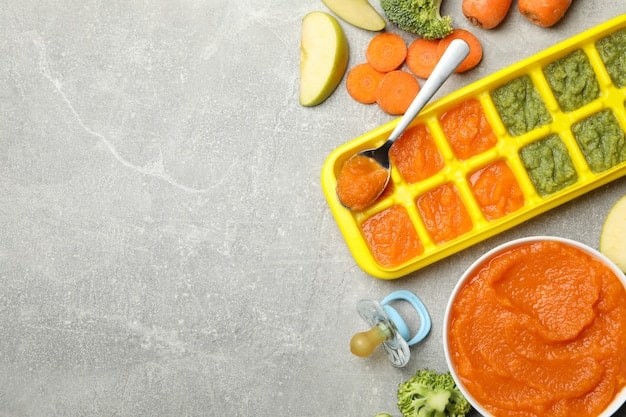
Optimal Containers for Baby Food Preservation
The type of container you use for storing baby food can significantly impact its freshness and longevity. Choosing the right materials and sizes can make all the difference. Let’s explore the best options available.
Silicone Freezer Trays: A Convenient Option
Silicone freezer trays are perfect for portioning out individual servings of baby food. Their flexibility makes it easy to pop out frozen cubes, and they are often dishwasher safe for easy cleaning.
Glass Jars: A Safe and Eco-Friendly Choice
Glass jars are an excellent option for storing baby food in both the refrigerator and freezer. They are non-toxic, easy to sterilize, and prevent plastic odors from seeping into the food.
BPA-Free Plastic Containers: Lightweight and Versatile
BPA-free plastic containers are a lightweight and practical choice for storing baby food. Ensure they are specifically designed for food storage and safe for freezing to avoid any leaching of harmful chemicals.
- ✔️ Silicone Trays: Ideal for single servings and easy removal.
- ✔️ Glass Jars: Safe, eco-friendly, and easy to sterilize.
- ✔️ BPA-Free Plastic: Lightweight and versatile for on-the-go use.
Selecting the right container is crucial to prevent freezer burn and maintain the quality of your homemade purees. Now, let’s consider the best freezing techniques for long-term storage.
Freezing Techniques to Maximize Freshness
Freezing is an excellent way to extend the shelf life of your homemade baby food. Proper freezing techniques are key to maintaining the food’s texture, flavor, and nutritional value. Here’s how to freeze baby food like a pro!
Portioning for Convenience
Before freezing, divide the baby food into individual portions using silicone trays or small containers. This makes it easy to thaw only what you need, reducing waste and ensuring you always have a fresh serving on hand.
Cooling Before Freezing
Allow the cooked baby food to cool completely before placing it in the freezer. This helps prevent the formation of large ice crystals, which can negatively affect the texture of the puree.
Sealing and Labeling
Ensure the containers are tightly sealed to prevent freezer burn. Label each container with the date and contents so you can easily track freshness and avoid any mix-ups. This also helps with inventory management, ensuring you use the oldest batches first.
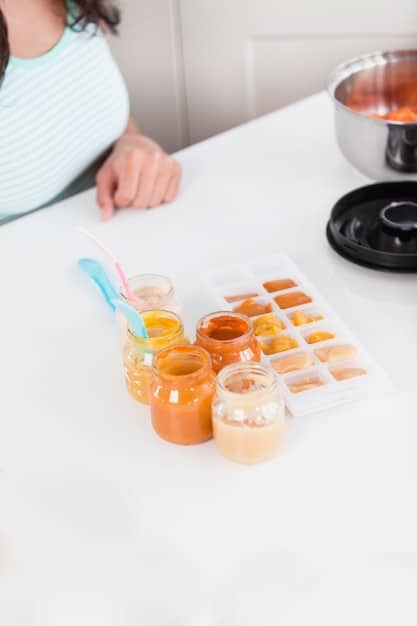
- 🧊 Portioning: Divide into single servings for easy thawing.
- 🌡️ Cooling: Cool completely to maintain texture.
- 🏷️ Labeling: Date and label to track freshness and contents.
Freezing is an art that requires attention to detail. With these techniques, your baby’s food will stay fresh and nutritious for longer. Moving on, let’s discuss proper thawing methods to preserve quality and safety.
Safe Thawing Methods for Baby Food
Thawing baby food properly is just as important as freezing it correctly. Safe thawing methods ensure that the food remains free from bacteria and retains its nutritional value. Let’s examine the best ways to thaw your homemade purees.
Refrigerator Thawing: Slow and Steady
The safest method is to thaw the baby food in the refrigerator overnight. This slow thawing process helps prevent bacterial growth and ensures the food remains at a safe temperature.
Microwave Thawing: Quick but Careful
If you need to thaw the baby food quickly, you can use the microwave. However, be sure to heat it evenly and stir frequently to avoid hot spots. It’s best to use this method only when necessary.
Avoiding Room Temperature Thawing
Never thaw baby food at room temperature, as this can create an environment that promotes rapid bacterial growth. Always use the refrigerator or microwave to ensure safety.
By using these safe thawing techniques, you can ensure that your baby’s food remains nutritious and free from harmful bacteria. Remember, safety is always the top priority when it comes to feeding your little one. Now, let’s cover how long you can store baby food safely.
How Long Can You Store Baby Food?
Knowing how long baby food can be safely stored is essential for preventing spoilage and ensuring your baby receives nutritious meals. Different storage methods offer varying shelf lives. Let’s break down the recommended storage durations.
Refrigerator Storage
Homemade baby food can typically be stored in the refrigerator for up to 48 hours. After this time, the risk of bacterial growth increases, and the food may no longer be safe for your baby.
Freezer Storage
When properly frozen, baby food can maintain its quality for up to 3 months. Be sure to use airtight containers and follow proper freezing techniques to maximize its shelf life.
Commercial Baby Food
Commercial baby food jars should be stored according to the manufacturer’s instructions, typically found on the packaging. Once opened, they should be refrigerated and used within 24-48 hours.
- ✔️ Refrigerator: Up to 48 hours.
- ✔️ Freezer: Up to 3 months.
- ✔️ Commercial Jars: Follow manufacturer’s instructions; usually 24-48 hours after opening.
Adhering to these storage timelines will help ensure your baby receives safe and nutritious meals. Now, let’s examine factors that can affect the shelf life of baby food.
Recognizing Spoilage and Safety Tips
Identifying signs of spoilage in baby food is vital for preventing your baby from consuming unsafe food. Always be vigilant and aware of what to look for. Let’s discuss the key indicators of spoilage and essential safety tips.
Signs of Spoilage
Look for changes in color, texture, or odor. If the baby food appears discolored, has a slimy texture, or smells sour, it’s likely spoiled and should be discarded immediately.
Taste Testing
Although it might seem counterintuitive, taste-testing a small amount can sometimes help determine if the food has gone bad. However, if you have any doubts, it’s always best to err on the side of caution and throw it away.
General Safety Tips
Always use clean utensils when handling baby food and avoid double-dipping. Wash your hands thoroughly before preparing or serving food to minimize the risk of contamination.
| Key Point | Brief Description |
|---|---|
| 🧊 Proper Freezing | Cool food before freezing to maintain texture. |
| 🏷️ Labeling | Date and label containers for easy tracking. |
| 🌡️ Thawing | Thaw in the refrigerator to prevent bacterial growth. |
| ✔️ Storage Time | Refrigerate for 48 hours, freeze for up to 3 months. |
Frequently Asked Questions
▼
It is generally not recommended to refreeze baby food after it has been thawed, as this can increase the risk of bacterial growth and compromise the food’s texture and nutritional value.
▼
Yes, glass containers are safe for freezing baby food as long as they are freezer-safe and have enough headspace to allow for expansion. Avoid filling the jar to the very top.
▼
You can sterilize baby food containers by boiling them in water for 5-10 minutes, using a steam sterilizer, or running them through a dishwasher cycle with a sanitizing option.
▼
Use waterproof labels and a permanent marker to clearly mark the date and contents on each container. This helps you keep track of freshness and avoid mix-ups when using frozen batches.
▼
Yes, adding spices to baby food before freezing is generally safe. However, use spices sparingly, especially when introducing new flavors to your baby, to avoid overwhelming their palate.
Conclusion
Proper baby food storage is a critical aspect of ensuring your homemade purees are safe, nutritious, and convenient for your little one. By following these guidelines—selecting the right containers, employing effective freezing techniques, and practicing safe thawing methods—you can confidently provide your baby with the best possible start to healthy eating.
